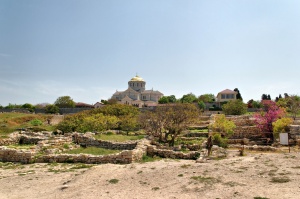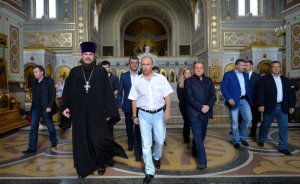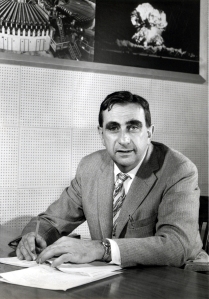Archaeology in the Age of Special War
“Everything is very simple in War, but the simplest thing is difficult. These difficulties accumulate and produce a friction which no man can imagine exactly who has not seen War,” wrote Carl Von Clausewitz in his classic magnum opus On War. Friction, he theorized, was what “distinguishes real war from war on paper.”[1] In a hypothetical total war each side would increase its use of force in response to the other until one side was annihilated. In real life frictions intervene. Limited resources. Limited willpower. Human error. Rational calculations of interests which make negotiations a better option. All of these combine with a hundred other factors to prevent war from reaching its ideal state.
Clausewitz, however, wrote in the West, where a very specific set of customs was coded into the cultural conception of “war.” Wars began with declarations, were decided on the battlefield in a violent and decisive struggle between combatants, and ended with peace treaties. The goal, according to Victor Davis Hanson, was to “focus a concentrated brutality upon the few in order to spare the many.”[2] The savage violence unleashed on battlefields from classical Greece to Gettysburg and Verdun was actually a way to limit the destructiveness of war to one segment of the population.

“War is not merely a political act, but also a real political instrument, a continuation of political commerce, a carrying out of the same by other means.” — “On War,” 1.24
Every culture has its own customs to limit the destruction caused by war. Islamic hadith on warfare forbid destroying wells, killing livestock and burning orchards so as to not devastate the areas affected by war. The second Caliph, Abu Bakr, issued orders forbidding killing women, children or Christian monks.[3] The Biblical book of Deuteronomy likewise forbids destroying orchards and requires that enemy cities be given a chance to surrender before they are besieged.[4] During violence following a disputed election in Kenya in December 2007, Time magazine reported on fighting between the Maasai and Kalenjin where each side met at dawn in a field to shoot arrows at each other from a distance. According to one combatant, “Here, we believe in fighting on a battlefield. We don’t go at night to attack. It’s no good.”
But it was the Western method with its focus on channeling war’s destructiveness into massed firepower which proved dominant. It resulted in the creation of more and more powerful weapons with which to win the battlefield struggle, allowing western armies to dominate most non-western ones.[5] As a result, international laws of warfare are based on the Western cultural conception of war. The Third Geneva Convention only affords protections to guerrillas if they maintain a chain of command, wear uniforms, and carry arms openly – that is, if they abandon everything that would make them effective as guerrillas. Collective punishments are prohibited by the Fourth Convention, since war is viewed as being fought between combatants and not by the society supporting them.[6]
(It should of course be noted that recognizing the cultural context from which certain beliefs about the proper conduct of war arose does not mean that these beliefs are wrong, baseless, or should be abolished).
But the Western method has run into increasing complications in the past seventy years. In post-colonial conflicts in the latter half of the twentieth century guerrilla war was the chosen tool to counter Western (and Soviet) conventional supremacy. Guerrilla warfare and terrorism sought to avoid the concentration of force and fight asymmetric battles, using the West’s own rules against it while avoiding its strengths. But terrorism and guerrilla warfare rarely work as planned. Terrorist organizations usually turned popular opinion against themselves, and guerrilla war typically resulted in lengthy stalemates that cost hundreds of thousands of lives with few results.
But this does not mean that state-to-state warfare has again proved triumphant. The constant search for a technological edge on the battlefield means that modern military forces are fantastically expensive. The U.S. military spent $67,000 per soldier per year during World War 2, $132,000 in Vietnam, and $1.1 million in Afghanistan. The gear required to outfit a single American infantryman cost $170 for World War 2, $1,100 in Vietnam, and $17,500 in Afghanistan.

Three generations of American fighter aircraft. P-51 Mustang, $660,000 each (in 2015 dollars), 15,586 built. F-15C, $30 million each, 483 built. F-22, $163 million each, 182 built. (source)
Weapons systems are even more expensive and complex and as a result are being produced in fewer numbers. In 1960 the U.S. Air Force fielded 1,735 strategic bombers, now it has 96. Twenty of those are B-2 stealth bombers which cost over $1.1 billion each. The F-35 Joint Strike Fighter is now the most expensive weapons program in the history of the world, with each plane costing more than five times as much as the F-16s it will replace.
Of course, each new weapon has far greater capabilities than the old ones, but the incredible lethality of modern missiles and other smart weapons means that in war between modern military forces equipment will be destroyed at a prodigious rate. When aircraft, ships and tanks cost hundreds of millions of dollars or more per unit and take years to manufacture, losses cannot be quickly replaced. When countries field fewer systems their forces are depleted faster.
As a result, wars between modern armed forces now end very quickly. It took the American and British armed forces three weeks to capture Baghdad in 2003. In five days in August 2008 the Russian military “largely destroyed Georgia’s war-fighting capability” and forced that country to surrender.
War, therefore, is now an extremely high risk endeavor. A few terrible days may be enough to decide the outcome of a conflict and leave one side at the mercy of the other’s armies.
A few recent conflicts have shown the likely future of conventional war. During the Kosovo War in 1999 Serb troops dispersed into the countryside, camouflaged their equipment, and made heavy use of decoys. As a result, Serbia’s army suffered few casualties from three months of aerial bombardment. In Lebanon in 2006, Hezbollah maintained a dispersed, defensive posture while counterattacking at Israel’s civilian population with rockets. Political pressure to stop the rocket fire forced Israel into fighting a battle in Lebanese territory on Hezbollah’s terms, suffering heavy casualties and causing heavy damage and civilian casualties in Lebanon which were exploited by Hezbollah to bring international condemnation. Similar tactics have been utilized by Hamas in Gaza.
Each strategy involves expanding the areas being fought over – the ‘battlespace’ in military parlance – into the civilian population, the media and public opinion rather than betting the outcome of the conflict on one major clash between armies in a battle they are likely to lose. In the most abstract terms, it is a plan designed to mitigate risk by diversifying the investment of resources.
The emerging next phase in this process is what has variously been termed “Hybrid Warfare” or “Special War.” According to military historian John Schindler, Special War is “an amalgam of espionage, subversion, even forms of terrorism to attain political ends without actually going to war in any conventional sense.” Special War certainly involves fighting, but often on a limited basis or with a certain level of plausible deniability. Instead of waging conventional war, Special War expands conflict into numerous spheres: information, the media, public opinion, economics, intelligence, sabotage, espionage, cyberwarfare, insurgency, political leverage, covert action, and military force stopping short of major war. Special War as a strategy involves asserting power through all of these sectors in order to bring about desired policy objectives.
The most oft-cited example of Special War is the current war in Ukraine, where Russia launched an undeclared invasion of Crimea with “Little Green Men” in unmarked uniforms, officially denying everything as their forces took advantage of Ukraine’s post-revolution confusion and occupied Crimea with little resistance. Russia’s intervention in eastern Ukraine has never been officially acknowledged as Russia maintains the only troops in the region are Ukrainian separatists, while doing its best to destabilize Ukraine using all means at its disposal. Another proponent of special war is Iran, whose proxy armies give it significant influence in Lebanon, Syria, Iraq and Yemen despite having very few troops of its own in those countries.
As Special War seeks to expand conflict into as many arenas as possible, it is likely that archaeology will become a tool of warfare.
The most widely covered example, of course, is how the Islamic State in Iraq and Syria has used the performative destruction of cultural heritage sites to erase evidence of opposing ideologies, undermine national and pre-Islamic identities, and portray themselves as heirs to the historical legacy of Muhammad, all in the service of creating a global caliphate which abolishes national borders and is ruled by their own extreme interpretation of Islam.
Archaeology, or more specifically, the destruction of archaeology, is now a strategy utilized in the service of ISIS’ stated strategic goals.

The ruins of ancient Chersonesus are dominated by St. Vladimir’s Cathedral, built over the site of Vladimir of Kiev’s baptism. (source)
Russia’s actions with regards to archaeology in Crimea have received far less attention. The ancient Greek colony of Chersonesus has long held religious significance for the Russian Orthodox church as the site where Prince Vladimir of Kiev was baptized in AD 988, bringing Christianity to Russia. Recent years have seen tension between the church’s desire to utilize the site as a holy site and scholars’ desire to excavate it. This past July Sergei Menyailo, Russian governor of Sevastopol, removed site director Andrei Kulagin and replaced him with Archpriest Sergei Khalyuta with the stated intention of turning the site into a monastery and pilgrimage site.
The move was supported by the Russian Orthodox church but provoked widespread opposition within the Russian scholarly community. A few weeks later, Vladimir Putin stepped to ostensibly play peacemaker by announcing that he was taking control of the site away from Menyailo and putting it under direct control of the Ministry of Culture.
In his State of the Nation address in December 2014, Putin called Chersonesus “the spiritual source of the development of a multifaceted but solid Russian nation and a centralised Russian state” and credited the Christianization of Russia with forming the various Russian peoples into one unified nation. He concluded, “All of this allows us to say that Crimea, the ancient Korsun or Chersonesus, and Sevastopol have invaluable civilisational and even sacral importance for Russia, like the Temple Mount in Jerusalem for the followers of Islam and Judaism. And this is how we will always consider it.”

Vladimir Putin visits St. Vladimir’s Cathedral in Chersonesus, September 12, 2015. (Kremlin Press Service)
Putin’s actions are very different than those of ISIS, but nevertheless his words and actions show that the cultural significance attached to Chersonesus figures into his strategy of annexation in Crimea, playing an essential role in his irridentist vision of a restored and unified Russian nation. Chersonesus is therefore but one tool out of many in Russia’s Special War with Ukraine.
In conclusion, I submit that these trends may mean several things for the future of archaeology:
1) The decline of the state and the rise of nationalism means the use of archaeology as a tool of conflict will continue to increase. Putin defines Chersonesus as essential to Russian identity not based on citizenship and geography but based on cultural identity which transcends national borders.
2) The use of “mythical pasts” will continue to be important for the rise of nationalisms as they look to history in order to legitimize the present. Putin looks back to Vladimir of Kiev as a prototype for a unified state of Russians, while ISIS views the destruction of cultural sites as a recapitulation of Muhammad’s destruction of pagan cult sites in Mecca and Taif. Many nationalists will utilize historical scholarship to bolster their claims.
3) Concurrently, as nationalism’s ethos is to seek the interests of one’s own in-group at the expense of others, this process will result in a loss of common ground for discourse as each group clings to their own narrative and constructs their own version of the truth.

Teller at Lawrence Livermore National Laboratory in 1958. He once said of his role in developing the hydrogen bomb: “At the end of the war, most people wanted to stop…But I was the one person who put knowledge, and the availability of knowledge, above everything else.” (source: picture/quote)
4) Therefore, there is a strong possibility that our work as archaeologists and historians will be utilized in support of someone’s cause. Should we then continue to publish, knowing that our work may be used for purposes other than intended? Do we bear responsibility when someone else uses our work for evil?
The simplest ethical approach is to say that it is the duty of the archaeologist to discover things and the duty of the historian to publish an accurate rendering of the past. What other people do with that information is not our responsibility.
A possible parallel illuminating the dangers of this approach can be found in the career of Edward Teller. Like many Jewish professors purged from German universities in 1933, the Hungarian-born Teller emigrated to the United States, and like many others he was recruited to work on the Manhattan Project. Unlike Enrico Fermi, Leo Szilard, Robert Oppenheimer and others who grew to regret their roles in bringing about the nuclear age, he remained a strong advocate of nuclear weapons and began developing the more powerful hydrogen bomb.
Teller argued that it was his job as a scientist to discover what was possible to build, while it was up to others to decide how to use that knowledge. He once said “There is no case where ignorance should be preferred to knowledge — especially if the knowledge is terrible.”[4] In a 1987 essay titled “Should the Scientist be King?,” Teller argued:
Scientists need not and should not make the decisions about the uses of science and technology. Scientists have been trained in a peculiar manner. They are faced with surprising and sharply defined situations; they deal with puzzles that are like chess problems. With all the elements in hand, they make a choice. It may be difficult, but it can be done. And once the solution is found, there is no doubt about it.
Political decisions call for different abilities. They call for an understanding of a great number of facts. They call for decisions made on the basis of insufficient evidence. More than anything, politics calls for feeling and for compromise—things that the scientist in his magnificent but sharply circumscribed field has no occasion to practice. When he deals with the intricate but consistent web of nature, he may be a genius. In the ever changing world of human relations, he is a child.
Yet, as his many critics have pointed out, Teller’s scientific advocacy made him perhaps the most politically involved scientist of the twentieth century, from his advocacy of the hydrogen bomb and his testimony against Robert Oppenheimer, to his nuclear consulting for Israel, advocacy of nuclear power, and promotion of Ronald Reagan’s Strategic Defense Initiative. By arguing that such things were possible he lent credibility to the politicians who sought to promote them.
Many scientists of the twentieth century argued that scientific knowledge was a neutral factor which could be used for either good or evil, but Teller’s contradictions illustrate well the flaw in this thinking. Expanding human knowledge expands what is possible to do with that knowledge. Expanding the realm of the possible affects the political. There is no truly neutral ground. One can either choose to speak or choose to remain silent – each has its own consequences.
Does this mean research into the archaeology of conflict zones should cease until peace reigns? Not at all, for remaining silent could affect the narrative just as much as announcing new discoveries.
When a scholar contrasts ISIS’ actions with those of the early caliphs, maybe someone will read it and be dissuaded from joining ISIS. But when one writes something that has such an effect, one has become in some small way a party to the conflict. The scholar may not have explicitly picked a side, but they have helped a side.
This is not to say that scholars should not correct distortions of the historical record. Few will question the morality of aiding the fight against ISIS. But in future conflicts of the twenty-first century, the moral choices may not be so clear.
There are not likely to be easy answers to the problems of twenty-first century archaeological ethics, but we must start by asking the right questions. It is humbly hoped this essay will further this conversation.
References:
[1] Carl Von Clausewitz, On War (trans. by Col. J.J. Graham), Book 1.7.
[2] Victor Davis Hanson, The Western Way of War: Infantry Battle in Classical Greece (New York: Alfred A. Knopf, 1989), 224.
[3] Yousef H. Aboul-Einen and Sherifa Zuhur, Islamic Rulings on Warfare [Strategic Studies Institute Monographs] (Carlisle, Pennsylvania: U.S. Army War College, 2004), 21-24.
[4] Deuteronomy 20:10-20.
[5] See for example the argument put forth in Kenneth Chase, Firearms: A Global History to 1700
(Cambridge University Press, 2008), 197-207.
[6] Third Geneva Convention, Article 4, 1-2; Fourth Geneva Convention, Article 33.
[4] Silvan S. Schweber, In the Shadow of the Bomb: Oppenheimer, Bethe, and the Moral Responsibility of the Scientist (Princeton University Press, 2000), 18.
Article © Christopher Jones 2015.







You have a strong anti-Russian bias.